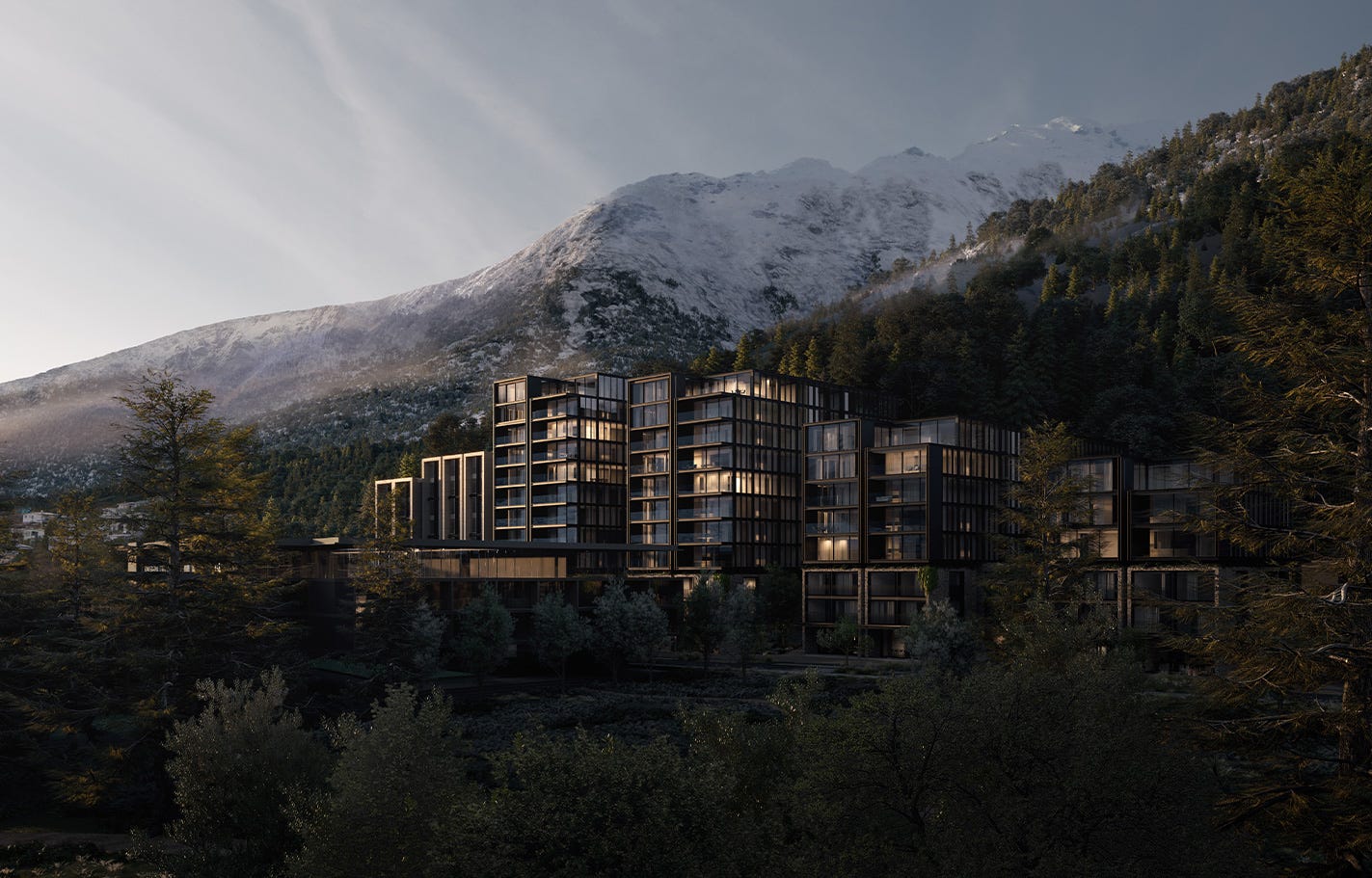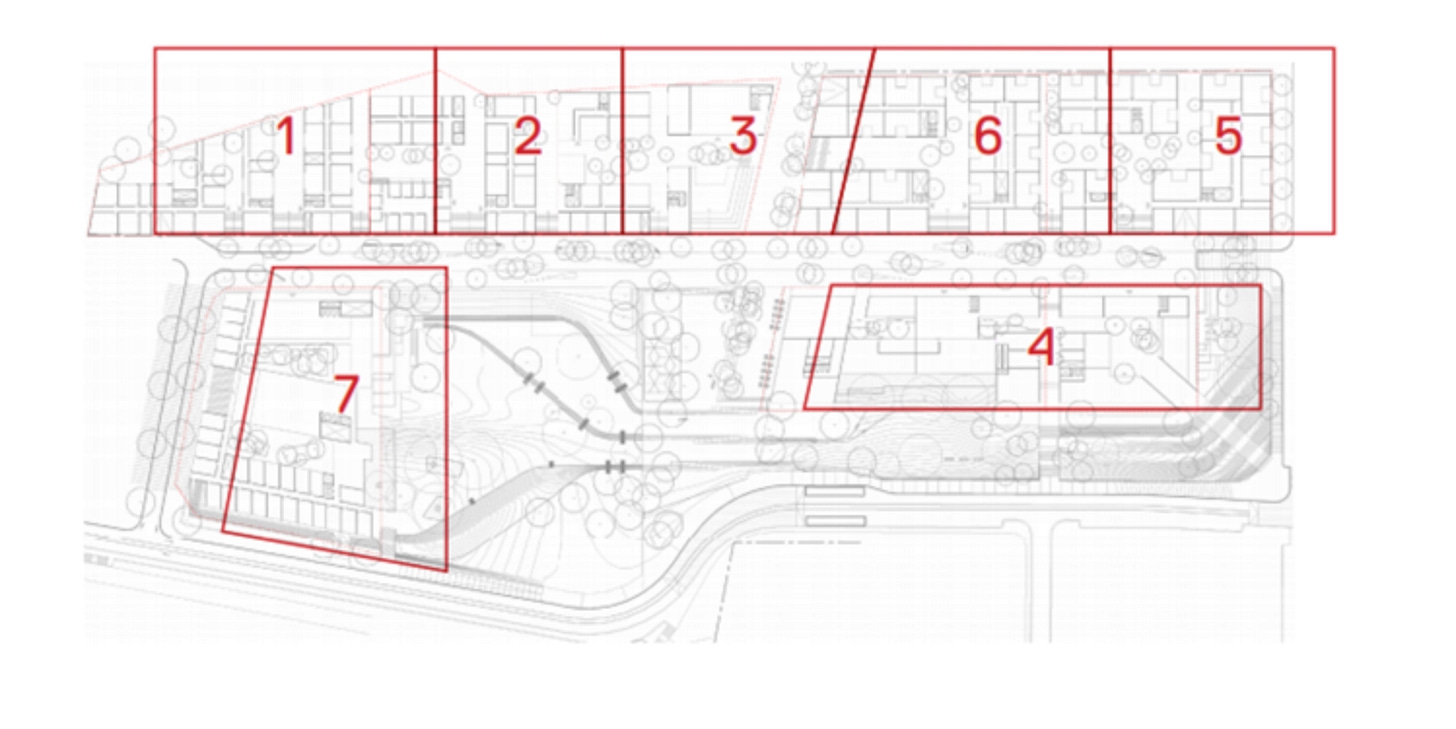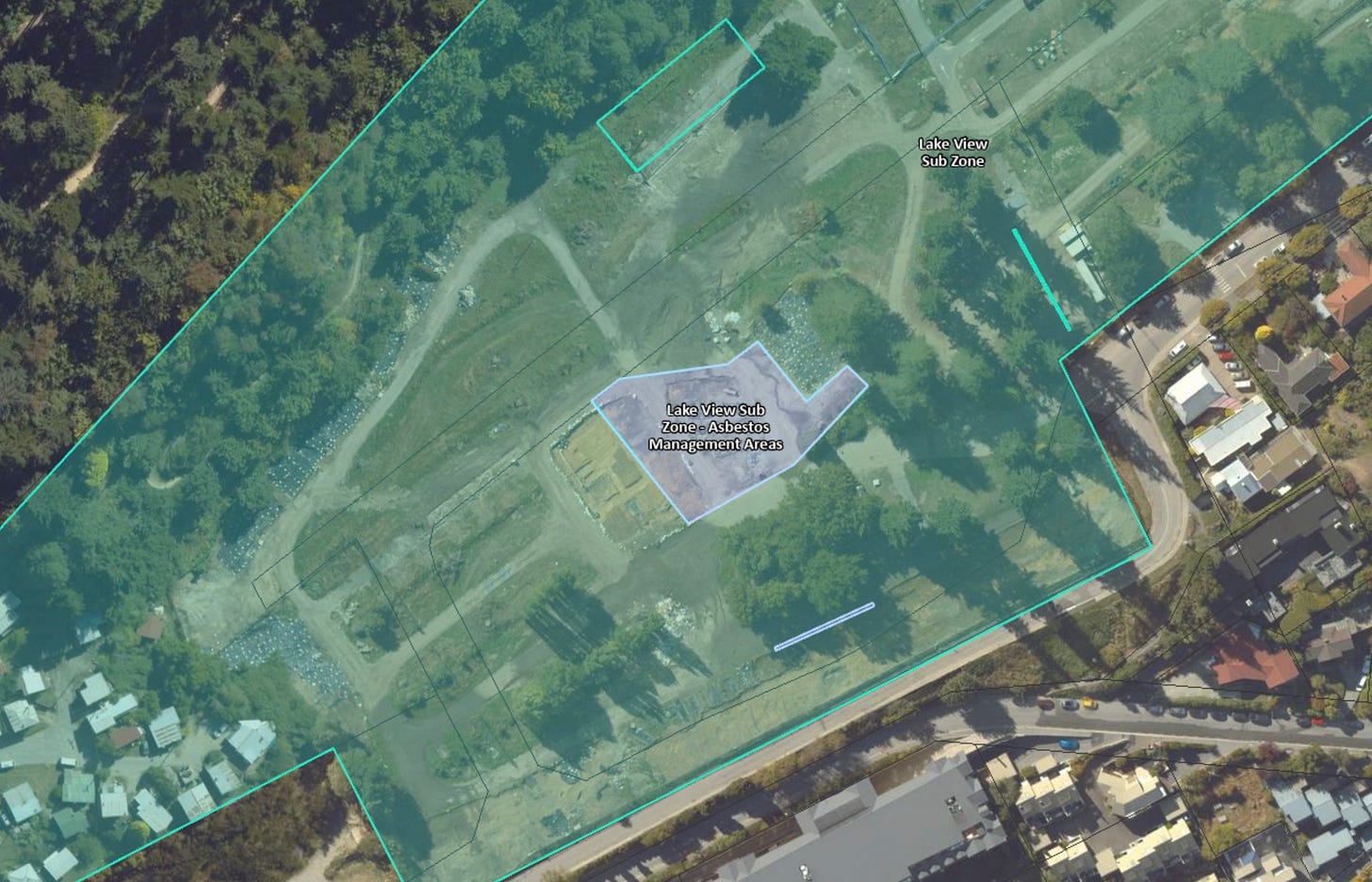Lakeview Part 1: Early mistakes and a flawed vision
Our investigation reveals early advice that the site was contaminated with asbestos
This investigation, funded by Crux paid subscribers, examines how a $2 billion Australian luxury property development in the centre of Queenstown started life as a “risk free investment” by the Queenstown Lakes District Council. In ten parts we will tell the story of how a large piece of ratepayer owned prime real estate, valued at $42 million in 2017, was turned into a black hole that so far has cost ratepayers over $100 million, increased rates and may not get built. Crux also acknowledges the role of Google’s Pinpoint investigative journalism tools and will publish, in the public interest, each part without a paywall three days after paid subscribers receive this content.
A Bad Start.
Lakeview got off to a bad start for a very dramatic and poignant reason. Low paid workers and their families already lived there in a series of cabins that were originally built for people on holiday from Dunedin and Invercargill.
The Lakeview cabins, now demolished by QLDC - old but valued by low income families.
The cabins were basic but filled a vital gap in Queenstown where there was an increasing affordable housing crisis. A Crux documentary at the time (The Last Affordable Place) told the full story, including interviews with the two Queenstown Lakes District Council managers who conceived a bold plan to sell the land to developers - CEO Mike Theelen and special projects manager Paul Speedy.
QLDC Chief Executive Mike Theelen (left) and Lakeview project manager Paul Speedy
This is how the QLDC trumpeted the Lakeview project in 2019.
“In October 2019, we signed a development agreement with Melbourne-based developer Ninety Four Feet and Auckland-based investment company Augusta Capital for development of the Lakeview land. Through this partnership, and others with Ngāi Tahu Tourism and Well Smart Ltd, the Lakeview Precinct will become a vibrant and complementary extension of the existing town centre. The site will offer residential buildings, hotels, co-working and co-living spaces, hospitality and retail, and a hot pools attraction. Construction will be phased over seven stages and is estimated to take more than ten years to complete.”
Source: QLDC.
Of course, even back then, residents were concerned about cost and risk. But the council’s comms team shared this plan:
QLDC: Lakeview Project Objectives
Maximise financial return in a manner that minimises risk to ratepayers
Establish a thriving residential focused, mixed-use precinct, which is stitched into the Queenstown town centre context and:
Exhibits best-practice urban design principles, is walkable, activated, liveable and authentic;
Exhibits a consistent design language and high-quality built form outcomes that complement the natural environment, fit into the Queenstown context and are of human scale;
Provides a diverse retail mix which complements and provides for the natural expansion of the existing town centre core and will appeal to locals and visitors;
Provides for the intensification sought via Plan Change 50 and delivers a variety of housing outcomes and/or a diverse residential community;
Considers opportunities for visitor accommodation and/or visitor facilities where these are economically viable.
Ensure Lakeview's development potential is unlocked in a timely and efficient manner.
Source: QLDC. 2016.
As shiny and commendable as this vision was our Crux investigation has revealed an early, serious error that was to become a sign of things to come.
A Contaminated Site.
Important as the original social goals were, a key factor in the Lakeview project for both the council and the developers was money. For the Australians it started as a $1 billion construction project and is now at least a $2 billion project - that’s if it ever gets built at all.
Crux actually met the developers back around 2017 on a flight into Queenstown. It was not the company bosses but a bunch of middle management and comms people. They’d clearly had a few wines and were celebrating a big deal in Queenstown. Their behaviour was very similar to a group who had struck gold or won the lottery.
Many years later we discovered why the developers were so happy. According to a confidential source, quoting Lakeview team members, QLDC CEO Mike Theelen had offered to cover all of their Lakeview development costs. It was such an unusual offer that not only did it leave the Australian Lakeview development team very happy - but also confused as to why such an unexpected council offer would be made.
Based on $400,000 worth of advice from property consultants CBRE, and a land valuation of $42 million from real estate firm Colliers, the council had come up with a very unusual plan - with an unusual motive. They were going to cover the development and land preparation costs from ratepayer funds, and give the Australians 20 years to pay for the land - in instalments linked to construction phases.
The motive that QLDC shared with the community was control. The council says that it wanted to control the project so it met all of their social and economic goals. If the goals were not being met they could theoretically not release all of the land.
The Lakeview site was to be released in phases over a 20 year period in order to “keep control of the project.”
It’s not clear how much due diligence the QLDC did on their own land but a Google Pinpoint search has revealed a 2021 submission on the project from the Otago Regional Council as part of the Fast Track approval process. The submission highlights significant pre-existing natural and man made issues with the Lakeview site, including asbestos, from an ORC hazards database that goes back to 1958.
Source: Otago Regional Council public submission on Lakeview released under the Official Information Act.
A subsequent search of the ORC’s HAIL (Hazardous Activities and Industries List) shows Lakeview clearly identified as an asbestos site.
The ORC’s HAIL database clearly details the Lakeview asbestos risk.
Here is the detail from the ORC HAIL database entry for Lakeview on Friday June 19, 2025.
“Human Health Context - High Density Residential
Mitigation Status: Partially Completed
Ecological Context: Not Applicable
Summary: Asbestos Management Areas referenced as Area 5B/Area 8 within part of the proposed reserve block near the centre of the site and a strip of material along the northern site of Area 1. An ongoing site management plan (OSMP ) has been developed for these pieces of land to ensure that appropriate controls remain in place indefinitely.”
Source: ORC HAIL database June 2025.
Even a technical survey carried out for the QLDC in 2018 at the Lakeview site by consultants E3S highlighted asbestos risks.
“Given the presence of asbestos building materials, the history of building demolition and suspected ACM surrounding demolition sites, there is a potential risk to contractors undertaking the redevelopment and people residing on the site long term.
“E3s understands development of the historical buildings would most likely involve removal or demolition of buildings and associated structures such as foundations.
“Given asbestos building materials are present, development within these areas will require management in accordance with the Health and Safety at Work (Asbestos) Regulations 2016. Management measures during building removal or demolition should include the management of asbestos in soil and consider requirements for off site disposal of soil.”
Source: E3S.
The Financial Impact of Asbestos Contamination.
The reason this asbestos presence is so important is that the QLDC presented an extra $6.3 million (later to become part of a $12 million cost) of site preparation and asbestos management costs to the community as being a surprise discovery.
In the beginning Mike Theelen and Paul Speedy had set expectations at around a total of $19 million cost for all site preparation and new underground services costs to be covered by ratepayers.
This was against a projected 20 year total income of perhaps $75 million - minus the value of the land and minus the site preparation costs. So $14 million profit (sometimes stated as $25 million before significant later cost increases) was about as much as they ever expected under the complex 20 year plan, whereas they could have sold the land outright for $42 million (2017 value - $68 million at current 2025 prices).
The decision not to make that outright sale will be a continuing theme throughout this investigative series.
It needs to be emphasised that the entire Lakeview Development Agreement has never been made public by QLDC, so some financial estimates are based on what councillors have told Crux and various leaked details around future “super profits.”
For the reasons above, an extra $6.3 million (year 1) on “unexpected” asbestos was a big deal. It almost doubled the site clearance costs and almost halved the total project surplus.
Did QLDC research the land and the ORC’s HAIL database before doing the Lakeview deal? Did they pay proper attention to their own 2018 contamination report from consultants E3S?
Here’s what they told the community in a media release at the time, on April 30th 2021.
“Queenstown Lakes District Council (QLDC) elected members have approved an additional $6.3M budget for cleaning up historic asbestos contamination from the Lakeview site.
“At the Council meeting yesterday, a planned 2020-2021 budget of $2.3M was extended to a total $8.6M for 2020-21 to ensure that asbestos containing materials (ACM) uncovered during site clearance can be handled, transferred and disposed of safely.
“QLDC Property Director Richard Pope said that the amount of asbestos containing materials discovered in the buildings and soil was significantly higher than had been originally expected. The materials discovered appear to be from historic activity prior to 1970.”
Rising Costs - and More Rising Costs.
This asbestos hit turned out to be just the first of many cost escalations, all at the 100% unlimited risk of the council and the ratepayer.
Eventually the site preparation costs were to spiral up towards $77 million (not including many affiliated projects that we will detail as part of this series) with that money going to the council’s controversial Wakatipu Transport Alliance. Or as they have become known - The Alliance.
The Alliance carries the official title Kā Huanui a Tāhuna - which translates as “the many fruit of Tāhuna (Queenstown).”
Controversy has come to surround The Alliance not just for sky high budgets and slow delivery (including $250 million BP junction and the $128 million “road to nowhere” which Crux has always believed is actually “the road to Lakeview”) but a conflict of interest declared by former QLDC mayor Jim Boult.
Mr Boult declared in a council register of interest that he was a member of an advisory board of Downer, one of The Alliance key members. Crux enquiries with Downer revealed there was no advisory board, just two people hired to directly advise the CEO of Downer - one of them being Jim Boult.
Crux coverage at the time raised a number of issues around this conflict and the secret nature of the entire development agreement with the Lakeview developers.
Part 2 of this investigative series will be published next Friday. Thanks to our paid subscribers for funding our work and to the Google Pinpoint project for the use of their investigative journalism tools.










The 1st story in and epic release about the murky world of smoke and mirrors and QLDC,s slippery slope to distrust.......
Extraordinary reporting … so fortunate that Crux is not deterred and continuing to shine the light on individuals who need to be held to account. Historically important documentation.